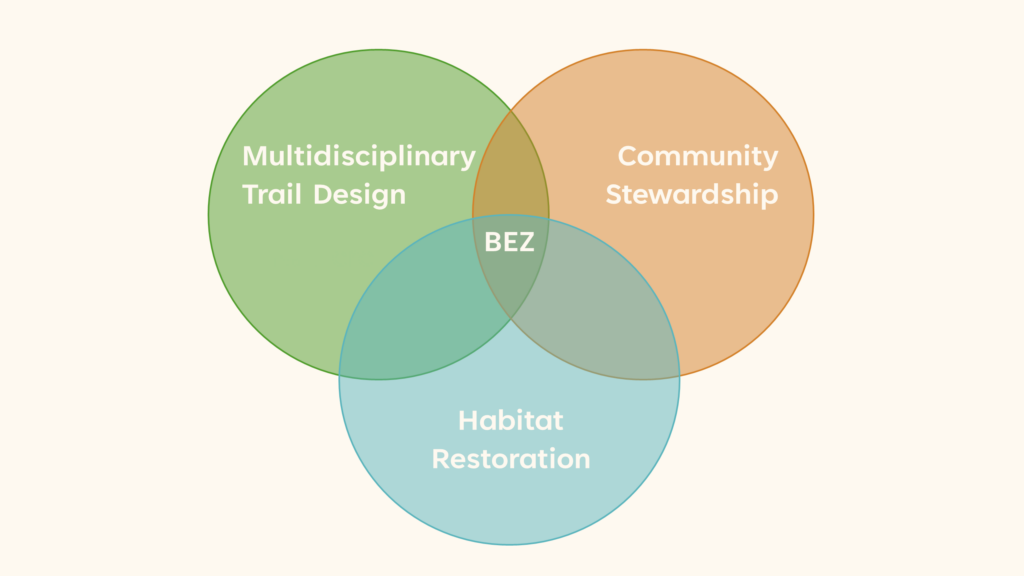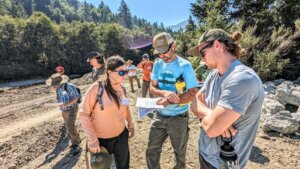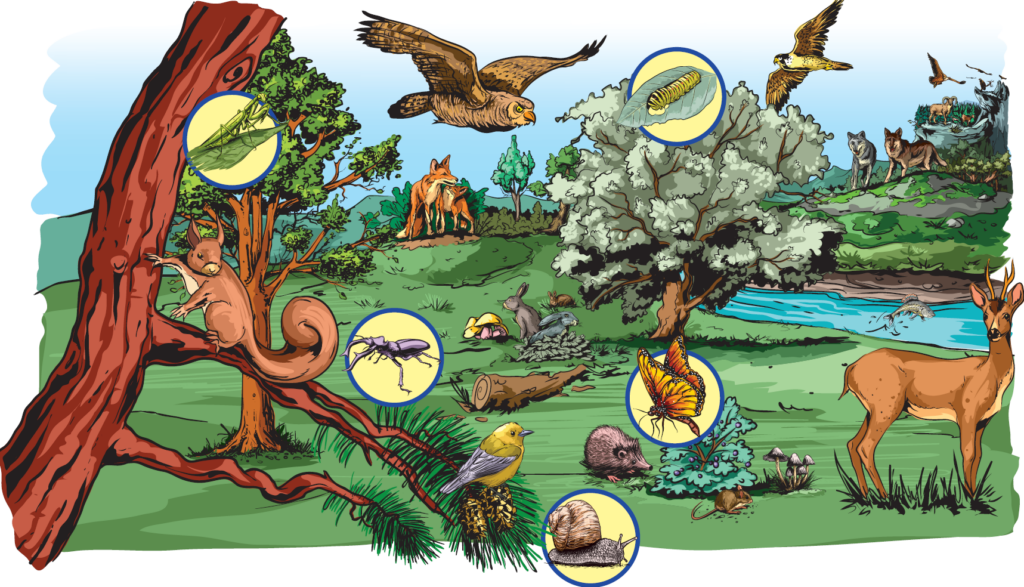Biodiversity Engagement Zones
When it comes to planning new trails or improving existing ones, traditional primary objectives center on trail design, construction, maintenance, and user experience. However, we also often have the opportunity to restore native habitats and engage a wider community in the process. In the field of recreation ecology, there is considerable research on the effects of recreational activities on ecosystem elements. Biodiversity Engagement Zones (BEZ) is a framework that uses a multidisciplinary planning method to integrate habitat restoration principles and practices into trail planning, design, and implementation, elevating both new and existing trail systems while fostering broader community engagement and education.
Process
The primary goal of the BEZ framework is to improve habitat condition biodiversity of trail systems to benefit water quality, wildlife, native plants, and climate change resiliency. This can be achieved by involving a diverse team of experts early in the planning stage, emphasizing science and collaboration. The framework incorporates the technical knowledge of trail design/construction, habitat restoration, hydrology, geology, and ecology professionals to identify suitable locations to site trails, restore habitats and integrate trail features, design conceptual specifications that provide trail builders, restoration practitioners, and land managers with detailed guidance to implement and incorporate restoration into trails and trail corridors.

Foundational Restoration Zones
The BEZ framework consists of four foundational zones: water quality, wildlife, vegetation, and resiliency. These zones should be tailored to align with current land management policies, plans, and strategies, while also accommodating specific objectives, geographical features, scale, and opportunities within the landscape and the local community.
1. Water Quality Zones aim to protect and enhance aquatic resources by effectively managing surface water, reducing erosion, protecting water quality, and conserving soil. Examples of restoration efforts within these zones include enhancing or restoring wetlands, riparian areas, and streams along the trail corridor. Trail design features such as at-grade reversals and rolling topography help capture and direct surface water into bioswales, which can manage runoff, recharge groundwater, and minimize erosion.
2. Wildlife Zones strive to establish or enhance wildlife habitat alongside or separate from the trail system. Tailored design concepts cater to diverse wildlife species, incorporating features such as basking stones, native pollinator plants, wildlife passage tunnels/crossings (e.g., for amphibians), greater wildlife corridor designation and enhancement, bird and bat boxes, and brush piles.
3. Vegetation Zones concentrate on establishing or restoring native vegetation including rare plant species; specific designs aim to enhance native grasslands, oak woodlands, riparian areas, and other sensitive vegetation communities. For example, deep rooted native grasses as well as mat-forming and rhizomatous species can be utilized to increase soil stability along trail margins.
4. Resiliency Zones utilize trails and their corridors to assist climate change challenges such as wildfire mitigation. Strategies such as shaded fuel breaks, fire tolerant species plantings, and forest thinning to enhance fire resilience while also maintaining early successional habitat to provide and maintain plant and animal biodiversity and micro-refugia for biodiversity.
The BEZ framework, along with its foundational zones, can be used for both new and existing trails. This application requires a baseline environmental and ecological assessment, with the understanding that additional information may be needed to complete the final designs.
Application
New trails offer the benefit of incorporating trail design and foundational zone restoration from the beginning, providing greater flexibility in terms of alignment and layout. This flexibility allows trails to be sited in a way that avoids or minimizes ecological impacts while integrating with existing restoration opportunities on the landscape. A distinct advantage of designing new trails is the potential to streamline the environmental permitting process. Traditionally, agencies or land managers address mitigation of natural resource impacts after the trail design phase, often as a response to permitting requirements for impacts on sensitive habitats. However, the BEZ framework advocates for integrating impact mitigation into the initial design phase, enabling a trail project to be self-mitigating. This proactive approach not only addresses potential impacts during the design phase but also enables restoration efforts to extend beyond basic mitigation requirements.
Existing trails present a more opportunistic approach to restoration along their corridors, driven by the trail’s current alignment and the habitats it crosses. Although they offer less flexibility to integrate trail tread improvements and restoration—such as managing surface water—they provide comparable opportunities to new trails for incorporating restoration zones within the trail corridor.

Community Engagement
The BEZ framework strives to offer opportunities to increase trail user community involvement in habitat restoration by cultivating a larger group of volunteer stewards. During the design process, technical guidance on restoration enables land managers to engage the trail-user community to implement specific restoration actions. Because each trail project and associated community is different, it is important to assess the appropriate level and frequency of anticipated community participation.
Summary
While the BEZ framework is innovative, it is not entirely novel—many of its elements have been independently developed and implemented by various agencies during the trail planning process. What sets BEZ apart is its cohesive approach, which brings together these previously scattered elements into a single, guiding framework.
This approach engages trail designers/builders and restoration practitioners, using a science-based approach to trail planning that engages a broader stewardship community in a more comprehensive and collaborative style. The application of BEZ has potential to be significant and depends on various factors such as the unique characteristics of trail segments, habitats along or near the alignment, goals and commitment of land managers, and available resources (including funding, personnel, and local community involvement) for implementation. Incorporating habitat restoration in trail planning presents an additional opportunity for projects to qualify for broader grant funding and facilitates additional interpretative opportunities.
By incorporating the BEZ framework into trail planning and implementation, it is possible to create a holistic approach that not only provides recreational opportunities but also contributes to the broader conservation and restoration of natural habitats, while fostering a deeper sense of stewardship and connection to the landscape.
Contact Us

E: richmond@wra-ca.com
Matt Richmond will present on and lead a panel to discuss “Biodiversity Engagement Zones: A Multidisciplinary Trails Planning Framework” at the California Trails & Greenways conference in Lake Tahoe on Thursday, May 2, 2024 at 9:15am as part of the Planning track. Panelists include Matt DeYoung with the Santa Cruz Mountain Trail Stewardship, Chris Orr with the International Mountain Bicycling Association, and Carl Sanders with the Marin Municipal Water District. Read more on our news page.




